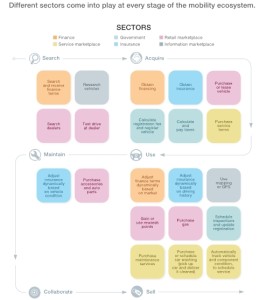Digitization is causing a radical reordering of traditional industry boundaries. What will it take to play offense and defense in tomorrow’s ecosystems?
Rakuten Ichiba is Japan’s single largest online retail marketplace. It also provides loyalty points and e-money usable at hundreds of thousands of stores, virtual and real. It issues credit cards to tens of millions of members. It offers financial products and services that range from mortgages to securities brokerage. And the company runs one of Japan’s largest online travel portals—plus an instant-messaging app, Viber, which has some 800 million users worldwide. Retailer? Financial company? Rakuten Ichiba is all that and more—just as Amazon and China’s Tencent are tough to categorize as the former engages in e-commerce, cloud-computing, logistics, and consumer electronics, while the latter provides services ranging from social media to gaming to finance and beyond.
Organizations such as these—digital natives that are not defined or constrained by any one industry—may seem like outliers. How applicable to traditional industries is the notion of simultaneously competing in multiple sectors, let alone reimagining sector boundaries? We would be the first to acknowledge that opportunities to attack and to win across sectors vary considerably and that industry definitions have always been fluid: technological developments cause sectors to appear, disappear, and merge. Banking, for example, was born from the merger of money exchange, merchant banking, savings banking, and safety-deposit services, among others. Supermarkets unified previously separate retail subsectors into one big “grocery” category. Changes such as these created new competitors, shifted vast amounts of wealth, and reshaped significant parts of the economy. Before the term was in vogue, one could even say the shifts were “disruptive.”
Yet there does appear to be something new happening here. The ongoing digital revolution, which has been reducing frictional, transactional costs for years, has accelerated recently with tremendous increases in electronic data, the ubiquity of mobile interfaces, and the growing power of artificial intelligence. Together, these forces are reshaping customer expectations and creating the potential for virtually every sector with a distribution component to have its borders redrawn or redefined, at a more rapid pace than we have previously experienced.
Consider first how customer expectations are shifting. As Steve Jobs famously observed, “A lot of times, people don’t know what they want until you show it to them.” By creating a customer-centric, unified value proposition that extends beyond what end users could previously obtain (or, at least, could obtain almost instantly from one interface), digital pioneers are bridging the openings along the value chain, reducing customers’ costs, providing them with new experiences, and whetting their appetites for more.
We’ve all experienced businesses that once seemed disconnected fitting together seamlessly and unleashing surprising synergies: look no farther than the phone in your pocket, your music and video in the cloud, the smart watch on your wrist, and the TV in your living room. Or consider the 89 million customers now accessing Ping An Good Doctor, where on a single platform run by the trusted Ping An insurance company they can connect with doctors not only for online bookings but to receive diagnoses and suggested treatments, often by exchanging pictures and videos. What used to take many weeks and multiple providers can now be done in minutes on one app.
In the article:
A world of digital ecosystems
Rising expectations
Strategic moves
Value at stake
China by the numbers
Alibaba
– $120 billion assets under management by Yu’E Bao
– 175 million total Alipay transactions in one day
– 44 percent of global mobile-wallet spending, achieved by Alipay
Ping An
– 346 million online users
– 130 million users of Ping An Good Doctor
– 25 million unique visitors daily to autohome.com.cn
Tencent
– 889 million WeChat users
– 70 minutes spent every day by average WeChat user
– 61 percent of users open WeChat more than ten times every day
– 46 billion “red packets” sent via WeChat for the lunar new year
Snapshots of the future
Consumer marketplaces
B2B services
Mobility
Emerging priorities for the borderless economy
More: http://www.mckinsey.com/
About the authors: Venkat Atluri is a senior partner in McKinsey’s Chicago office, Miklos Dietz is a senior partner in the Vancouver office, and Nicolaus Henke is a senior partner in the London office.
The authors wish to thank Miklos Radnai, Global Head of McKinsey’s Ecosystems Working Group, and McKinsey’s Tamas Kabay, Somesh Khanna, and Istvan Rab for their contributions to this article.

